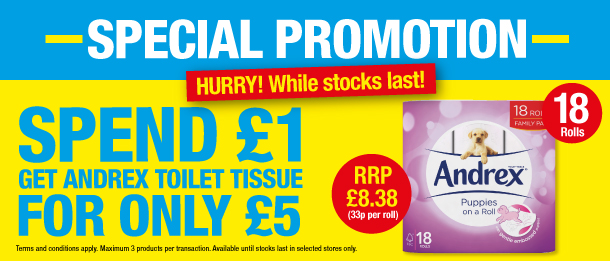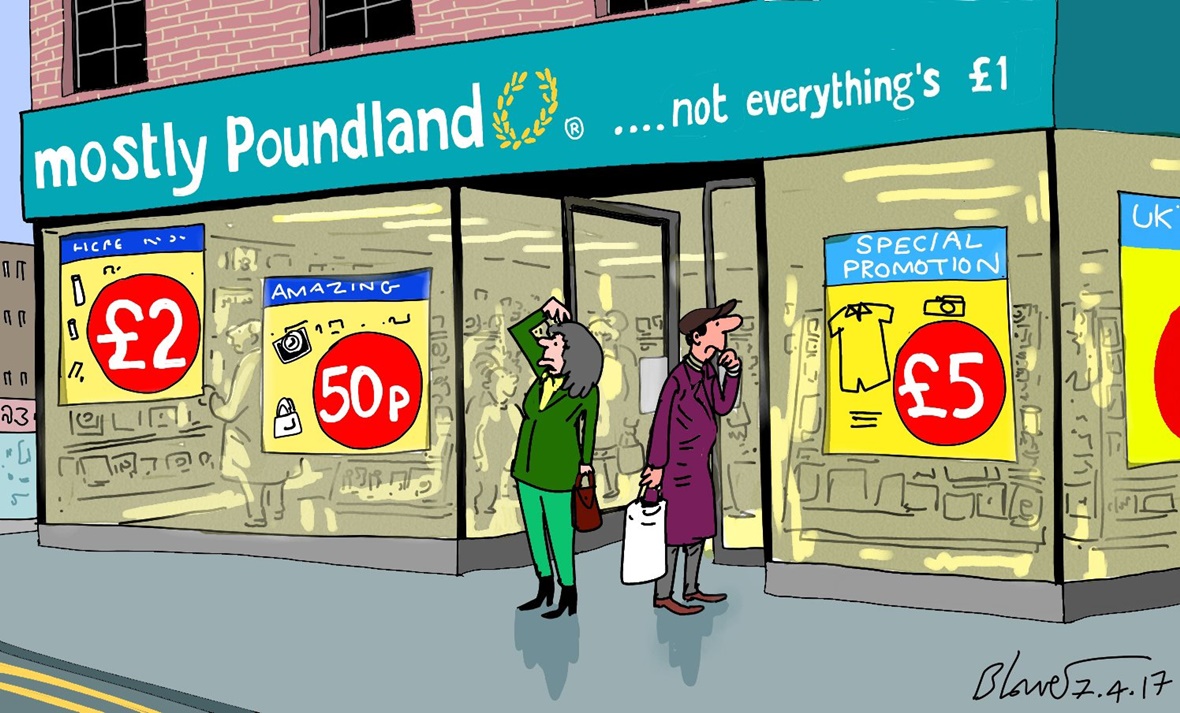Million Poundland Marketing
Discount Strategy
An example of over-£1 sales promotion.
Since popularising the concept of single-price retailing in 1990, British discount retailer Poundland has gone from strength-to-strength. Based on a strategy of selling products at a £1 price point, the company most recently generated revenue of £1.31 billion across 896 locations, employing over 18,000 people. Following its 2016 acquisition by retail giant Steinhoff International, Poundland is looking to expand further by occupying the high-street gap left by Woolworths. In pursuit of this goal, Poundland recently introduced low-cost clothing items as part of a broader strategy to sell items priced over £1.
Cartoonist Patrick Blower's take on Poundland's new pricing strategy.
Changing Retail Environment
The landscape of retailing has undoubtedly altered over the last three decades with the emergence of new retail formats and concepts. During this time, advancements in technology have helped retailers to create more efficient value chains that shift power away from suppliers. For example, sophisticated stock management systems now allow retailers to track every aspect of their stock from store level down to individual purchases. It is partly because of these market-driven processes that supermarkets, online stores and discount retailers have thrived at the expense of more traditional formats.
Recession-Proof Retailing
As a discount retailer, Poundland began trading by undercutting established competition to gain market share. The company’s unique concept of single-price retailing was particularly successful, resulting in twenty years of steady growth. By 2010, Poundland began capitalising on the demise of recession-hit retailers, moving into their former stores and extending product lines with items priced over £1. Offering clothing or other items that were historically difficult to sell at a £1 price point further demonstrated Poundland’s desire to wrestle market share away from established favourites such as George and Peacocks. The move to sell more expensive items has certainly proved a popular decision, as evidenced by claims that the brand is struggling to restock womenswear in line with demand. Clearly then, Poundland’s consumers are now willing to pay higher prices in return for increased value. Andy Bond, Steinhoff’s head of European operations, reiterated this sentiment by asserting: “We are bringing back to high streets the kind of clothing that was once loved.”
“...the brand is struggling to restock womenswear in line with demand.”
Incorporating Pep&Co Outlets
Tweaking Poundland’s already successful price structure to contain a relatively small number of items priced over £1 is a shrewd move, made efficient by joint retailing with fellow Steinhoff-owned brand Pep&Co. According to Pep&Co’s managing director, the firm will be able to offset rising costs because its venture with Poundland massively increases the volume of clothing ordered from suppliers. Coupled with the recent acquisition of close rival 99p Stores, placing full Pep&Co clothing outlets in larger stores may be described as a variation of ‘survival of the fittest’ known as ‘survival of the fattest’. In other words, the larger - or fatter - an organisation becomes, the more likely it is to succeed. Hence, acquisitions and joint retailing generally leads to concentrated power amongst a small number of large retailers who continue to become fatter and fatter. Such retailers utilise increased economies of scale and a strong negotiating position with suppliers to reinforce their power and domination over time.
Pep&Co branded clothing available at Poundland stores.
Room for Improvement
Poundland’s growth is impressive and looks set to continue, yet there is still space to grow. Building on recent momentum will be key moving forward, meaning further investment in additional retail locations around the country is advisable. Remember, the business is familiar with this process after recently expanding into 251 ‘99p Stores’. However, despite adapting to the business environment through acquisitions, joint retailing and new product innovations, surprisingly the most contemporary sales channel currently remains unused. Online expansion is of course the next logical step to take, especially considering rival discounters such as Home Bargains are currently ahead in this regard. Many other Steinhoff-owned brands successfully adopt a multichannel marketing approach, meaning there is no better time for Poundland to follow suit and once again take the discount revolution online.
If Poundland manages to keep pace with its competitors, it is likely that alongside the arrival of the shiny new £1 coin, the UK’s favourite discounter will likely shine too.




